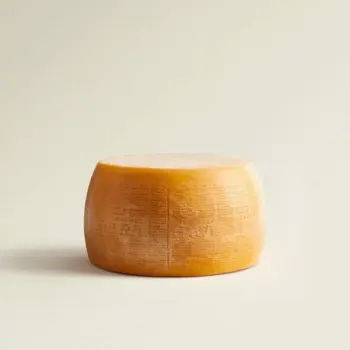Grana Padano and Parmesan are Italian cheeses with distinct flavors and textures suitable for various dishes, from pasta and risotto to soups and salads, with Parmesan offering a stronger taste and Grana Padano a milder alternative.

Grana Padano is a semi-hard cheese from Italy made from unpasteurized, semi-skimmed cow's milk. It has a slightly grainy texture with a rich, sweet flavor. It is aged for a minimum of 9 months and is often used in shavings or grated over dishes.

Parmesan, also known as Parmigiano-Reggiano, is a hard Italian cheese made from raw cow's milk. It is well-known for its complex, nutty taste and gritty texture. Parmesan is aged for a minimum of 12 months, though it can be aged for up to 36 months for a deeper flavor.
Grana Padano and Parmesan cheeses have distinct differences in taste, texture, aging process, and source. Grana Padano has a milder, buttery and less concentrated flavor, while Parmesan has a more intense, nutty and savory taste. Grana Padano is typically softer and less crumbly than Parmesan due to its shorter aging period. Additionally, Grana Padano can be produced in a wider geographical area, while Parmesan has a more restricted production zone in Italy.

Your ultimate Recipe Box, Meal Planner, and Cooking Class all in one
In pasta dishes like Fettuccine Alfredo or Pesto Pasta, Grana Padano offers a subtle cheese flavor that complements light and creamy sauces without overpowering them. Grana Padano melts smoothly, providing a velvety texture to the dish. Parmesan is ideal for bolder, more robust pasta dishes such as Spaghetti Bolognese or Penne Arrabbiata. Its stronger flavor profile stands up to hearty tomato-based sauces and enhances the complexity of the dish.
For a delicate and creamy Risotto alla Milanese, Grana Padano is a perfect choice. Its mild taste and creamy melting characteristics contribute to a smooth consistency while preserving the dish’s subtle flavors. When making a rich Risotto ai Funghi, Parmesan can add a savory depth that complements the earthy notes of mushrooms. The granular texture also adds a slight bite, which contrasts nicely with the creamy rice.
Grana Padano shavings can be used in salads like Caesar or mixed greens for a touch of flavor without overwhelming the other ingredients. In soups, it can be a gentle topping that melts into broths for added richness. Parmesan, grated over Minestrone or Pumpkin Soup, introduces a savory umami kick. In salads, particularly those with robust ingredients like radicchio or arugula, Parmesan's bolder taste can hold its own.
Both Grana Padano and Parmesan are excellent sources of protein and calcium, but their nutritional profile differs slightly due to the varying aging process.
| Nutrient | Parmesan ( Per Ounce ) | Grana Padano ( Per Ounce ) |
|---|---|---|
| Fat | 7g | 9g |
| Sodium | 450mg | 180mg |
| Calcium | 331mg | 300mg |
| Protein | 10g | 8g |
| Calories | 110 | 120 |
| Carbohydrates | 0g | 0g |
Yes, Grana Padano can be used as a substitute for Parmesan, especially in recipes where a milder cheese flavor is suitable. However, the overall flavor profile of the dish will be less intense.
Yes, Parmesan cheese typically has a stronger, more savory flavor compared to the milder Grana Padano due to its longer aging process.
Parmesan is often more expensive due to its longer aging process, which results in a lower yield and its PDO status that requires production in a specific region, following strict traditional methods.
Using Parmesan in place of Grana Padano will result in a stronger, not milder, flavor. For a milder flavor, the substitution should be the other way around.
Both cheeses can be grated over dishes, but Parmesan will impart a more robust flavor, while Grana Padano will be milder and more buttery in taste.